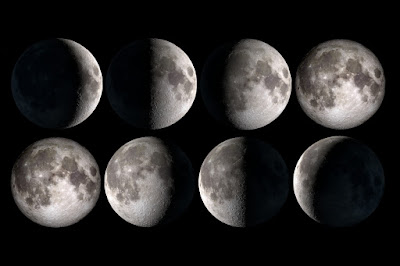As seen from Earth, the moon phase or the Moon cycle is the path of the Moon through the orbit of the Earth. The Moon's orbit is slightly elliptical; therefore, it moves slowly across the sky as the Moon orbits the Earth. As the Moon moves through each phase of its orbit, it passes through twenty-eight periods of perigee, i.e., one interval each day for four years and three weeks, and two perhaps, i.e., two periods each day for ten years and five weeks. The interval between the perigees and the apogee is about eight and a half days.
The Moon phases are named as such because they occur during the Moon's closest approach to the earth. They occur every four days during the entire year. The first phase, known as the Waxing Moon, is the earliest; it lasts from the first week of the New Moon to the full Moon of the New Moon. The second phase named the waning Moon, lasts for ten Moon months. The third phase, named the First Quarter, lasts from the Full Moon to the middle of the Moon period, which is the third week of December.
The fourth phase, the Waning
Crescent, occurs from the New Moon until the Full Moon. In the fifth phase, the
Nocturnal Moon occurs when the Moon is about to set; it is a little less
bright than the other Moon Phases. It is also a short phase. The sixth and
seventh phases occur during the autumnal equinoxes and spring equinoxes,
respectively. The last phase, named the Penumbral Moon, occurs when the Moon is
full.
During the entire year, The moon appears in ten different phases. Each phase has a different significance.
The first three-quarters of the Moon cycle is known as the Waxing Moon, the
first quarter being the first full Moon, the penumbral Moon, and the waning
crescent Moon. While there is no hard and fast rule on how to identify which
Moon Phase you are in, the easiest way to determine which Moon Phase you are in
is by comparing the time of your New Moon with the time of each of the four
Moon Phases.
What these different Moon
Phases mean is that they will affect your emotional and physical responses in
different ways. For example, the first quarter represents a period when you are
feeling especially happy, hopeful, and light-hearted. During the first quarter,
your energy level is higher than usual and you may have a strong feeling of
well-being. However, if the New Moon period happens during this period, you
will likely feel a sense of depression and you may even procrastinate, lose
interest in things you used to love doing, and even compromise your ideals.
When we speak of a Waxing Moon
we are talking about the Moon where the energy of the Moon is in its lowest
state. The term "waxing" comes from the fact that the Moon is at its
lowest state of vibrational energy when it is in its waxing phase. As it enters
its second and third quarters, the Moon is at its highest point of vibrational
energy. The Waxing Moon is a period of intense self-discovery in which you
learn to embrace and release your individuality so that you can fully come into
being as one with all mankind. It also represents a time when you begin to let
go of old beliefs that do not serve you well and when you begin to let go of
your past hurts and you begin anew.
The third quarter of the Moon plays host to the Full Moon, which occurs when the Moon is in its most distant phase, directly overhead. The Full Moon is the last and fullest phase before the Sunsets. This phase occurs in the northern hemisphere at sunset and it is generally the strongest and most dramatic of the Moon Phases. In the last quarter of the Moon, your power is at its greatest as you celebrate your passage into womanhood. The Waxing Gibbous and Full Moon represent two completely different and opposing forces of the Moon in our monthly chart.





No comments